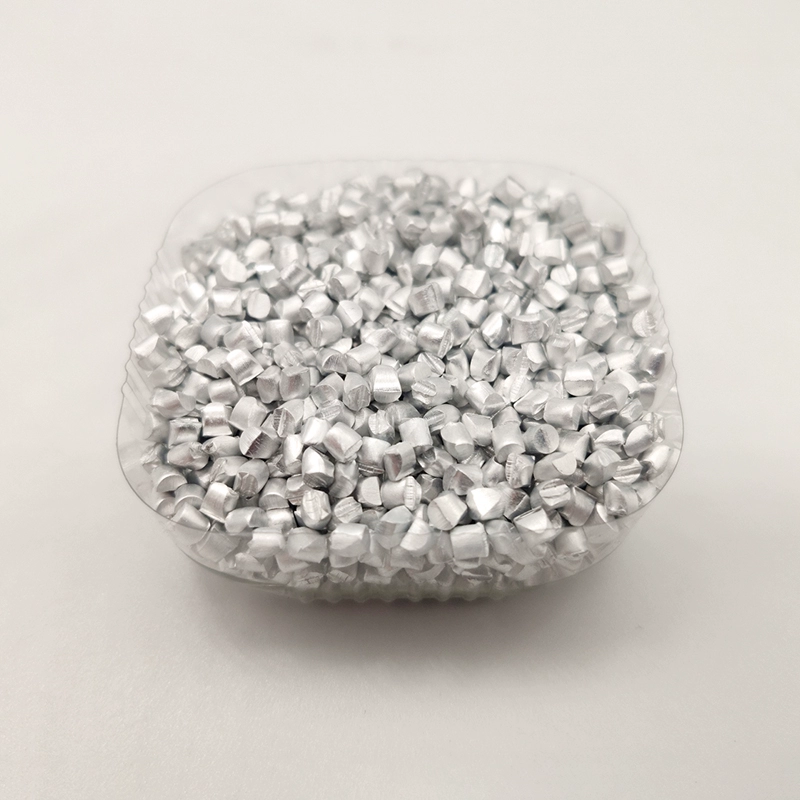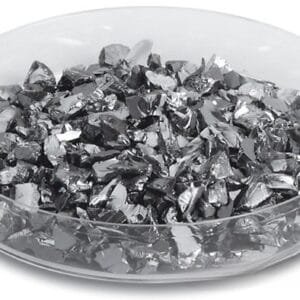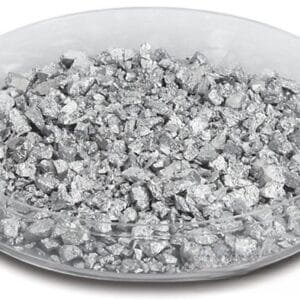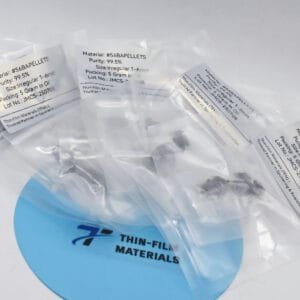Aluminum Evaporation Materials Description

Aluminum Evaporation Materials Specification
| Material Type | Aluminum |
| Color/Appearance | Silvery, Metallic |
| Purity | 99.9% ~ 99.9995% |
| Shape | Powder/ Granule/ Custom-made |
| Thermal Conductivity | 235 W/m.K |
| Melting Point | 660 °C |
| E-Beam | Excellent |
| Comments | Alloys W/Mo/Ta. Flash evap or use BN crucible. |
Aluminum (Al) Evaporation Materials Applications
Aluminum (Al) Evaporation Materials Packaging
Get Contact
TFM is a leading manufacturer and supplier of high-purity aluminum evaporating materials, including a broad range of evaporation pellets. We provide these materials in both powder and granule forms, with customized options available upon request.
Ordering Table
| Material | Size | Quantity | Purity | Part Number |
| Aluminum | 1/4" Dia. x 1/2" Length | 1 lb. | 99.95% | EVMAL1199QXH |
| Aluminum | 1/4" Dia. x 1/2" Length | 1 lb. | 99.99% | EVMAL40QXH |
| Aluminum | 1/4" Dia. x 1/2" Length | 50 g | 99.99% | EVMAL40QXHB |
| Aluminum | 1/4" Dia. x 1/2" Length | 100 g | 99.99% | EVMAL40QXHD |
| Aluminum | 1/4" Dia. x 1/2" Length | 250 g | 99.99% | EVMAL40QXHJ |
| Aluminum | 1/4" Dia. x 1/2" Length | 1 kg | 99.99% | EVMAL40QXHKG |
| Aluminum | 1/4" Dia. x 1/2" Length | 1 lb. | 99.999% | EVMAL50QXH |
| Aluminum | 1/4" Dia. x 1/2" Length | 50 g | 99.999% | EVMAL50QXHB |
| Aluminum | 1/4" Dia. x 1/2" Length | 100 g | 99.999% | EVMAL50QXHD |
| Aluminum | 1/4" Dia. x 1/2" Length | 250 g | 99.999% | EVMAL50QXHJ |
| Aluminum | 1/4" Dia. x 1/2" Length | 1 kg | 99.999% | EVMAL50QXHKG |
| Aluminum | 1/4" Dia. x 1/4" Length | 1 lb. | 99.95% | EVMAL1199QXQ |
| Aluminum | 1/4" Dia. x 1/4" Length | 1 lb. | 99.99% | EVMAL40QXQ |
| Aluminum | 1/4" Dia. x 1/4" Length | 25 g | 99.99% | EVMAL40QXQA |
| Aluminum | 1/4" Dia. x 1/4" Length | 50 g | 99.99% | EVMAL40QXQB |
| Aluminum | 1/4" Dia. x 1/4" Length | 100 g | 99.99% | EVMAL40QXQD |
| Aluminum | 1/4" Dia. x 1/4" Length | 250 g | 99.99% | EVMAL40QXQJ |
| Aluminum | 1/4" Dia. x 1/4" Length | 1 kg | 99.99% | EVMAL40QXQKG |
| Aluminum | 1/4" Dia. x 1/4" Length | 500 g | 99.99% | EVMAL40QXQT |
| Aluminum | 1/4" Dia. x 1/4" Length | 1 lb. | 99.999% | EVMAL50QXQ |
| Aluminum | 1/4" Dia. x 1/4" Length | 25 g | 99.999% | EVMAL50QXQ-A |
| Aluminum | 1/4" Dia. x 1/4" Length | 50 g | 99.999% | EVMAL50QXQ-B |
| Aluminum | 1/4" Dia. x 1/4" Length | 100 g | 99.999% | EVMAL50QXQ-D |
| Aluminum | 1/4" Dia. x 1/4" Length | 250 g | 99.999% | EVMAL50QXQ-J |
| Aluminum | 1/4" Dia. x 1/4" Length | 500 g | 99.999% | EVMAL50QXQ-T |
| Aluminum | 1/4" Dia. x 1/4" Length | 1 kg | 99.999% | EVMAL50QXQKG |
| Aluminum | 1/8" Dia. x 1/4" Length | 1 lb. | 99.999% | EVMAL50EXQ |
| Aluminum | 1/8" Dia. x 1/4" Length | 25 g | 99.999% | EVMAL50EXQA |
| Aluminum | 1/8" Dia. x 1/4" Length | 50 g | 99.999% | EVMAL50EXQB |
| Aluminum | 1/8" Dia. x 1/4" Length | 100 g | 99.999% | EVMAL50EXQD |
| Aluminum | 1/8" Dia. x 1/4" Length | 250 g | 99.999% | EVMAL50EXQJ |
| Aluminum | 1/8" Dia. x 1/8" Length | 1 lb. | 99.99% | EVMAL40EXE |
| Aluminum | 1/8" Dia. x 1/8" Length | 25 g | 99.99% | EVMAL40EXEA |
| Aluminum | 1/8" Dia. x 1/8" Length | 50 g | 99.99% | EVMAL40EXEB |
| Aluminum | 1/8" Dia. x 1/8" Length | 100 g | 99.99% | EVMAL40EXED |
| Aluminum | 1/8" Dia. x 1/8" Length | 250 g | 99.99% | EVMAL40EXEJ |
| Aluminum | 1/8" Dia. x 1/8" Length | 1 kg | 99.99% | EVMAL40EXEKG |
| Aluminum | 1/8" Dia. x 1/8" Length | 1 lb. | 99.999% | EVMAL50EXE |
| Aluminum | 1/8" Dia. x 1/8" Length | 25 g | 99.999% | EVMAL50EXEA |
| Aluminum | 1/8" Dia. x 1/8" Length | 50 g | 99.999% | EVMAL50EXEB |
| Aluminum | 1/8" Dia. x 1/8" Length | 100 g | 99.999% | EVMAL50EXED |
| Aluminum | 1/8" Dia. x 1/8" Length | 200 g | 99.999% | EVMAL50EXEH |
| Aluminum | 1/8" Dia. x 1/8" Length | 250 g | 99.999% | EVMAL50EXEJ |
| Aluminum | 1/8" Dia. x 1/8" Length | 1 kg | 99.999% | EVMAL50EXEKG |


 MSDS File
MSDS File



Reviews
There are no reviews yet.